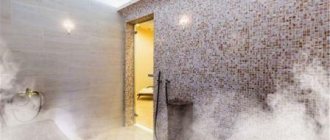In what cases should you not go to the bathhouse or sauna if you are sick?
For your information! Conjunctivitis can be viral, fungal, bacterial, allergic, and several other types associated with specific pathogens or epidemics.
Depending on each specific type, the severity of symptoms can be barely noticeable, moderate or very strong.
But visiting baths and saunas will in no case be useful for the inflammatory process, or rather, its elimination .
Visiting public places, especially such insidious ones, is fraught with unpleasant consequences - from the spread of infection to its addition.
Therefore, it is better to go to the steam room after recovery.
I'm finally breathing! How does a bath help ease breathing when you have a runny nose?
The bathhouse is a universal remedy for strengthening the immune system and fighting colds.
The combination of high temperatures and high humidity has a positive effect on human health, especially during colds. But there are both pros and cons of a cold that you should be aware of. To begin with, let us recall that a runny nose is an inflammation of the nasal mucosa, a natural reaction of the body to an encounter with a virus. Is it possible to go to the bathhouse with a runny nose? According to experts, it is worth going to the sauna for this type of disease in two cases:
- when a runny nose just started and a person felt the first signs of malaise,
- and also when the acute period of the disease has already passed and the person is at the stage of recovery.
Arguments for taking a bath when you have a runny nose
| Steam in a sauna helps to effectively cleanse the respiratory tract. |
- Steam inhalation. Wet steam has a positive effect on the respiratory system. Especially if you use bath decoctions from pine needles, eucalyptus, mint and others. Thanks to the aromatic steam, the nasopharynx, bronchi and lungs are cleared of mucus, which relieves a runny nose and cough, and reduces the risk of complications (sinusitis, pneumonia, etc.).
- Natural removal of toxins and waste. Cleansing of the body occurs due to accelerated metabolism under the influence of high temperatures in the sauna. A person actively sweats, and along with sweat, harmful waste and toxins come out of the body. This type of treatment is especially relevant at the recovery stage, when the body has defeated the virus and needs to get rid of decay products.
Note! It is the slagging of the body that hinders recovery and increases the likelihood of frequent colds and a lingering runny nose. Therefore, it is important to engage in prevention now by regularly cleansing the body.
- Relieving body aches. Massage with bath brooms is especially good for colds, since one of the symptoms of illness is body aches and joint pain that occur due to intoxication of the body. As a result of the massage, pain in the joints and muscles becomes less pronounced. Also, during a bath massage, a person inhales healing steam with the aroma of a broom (massage with linden, birch, and eucalyptus brooms is especially useful), thereby cleansing the nasopharynx.
View all hammams in St. Petersburg
Arguments against a sauna for a runny nose
| The steam room is useful for adults and children with residual cough and runny nose. |
- Body temperature is above average . An increase in body temperature indicates the body's fight against infection. By visiting a sauna with a runny nose and a temperature above 37 degrees, you are once again exposing your body to stress and risking serious heart complications.
- Acute stage of the disease. If you have a dry and frequent cough, a profuse runny nose, or in the midst of the development of the disease, you should avoid visiting the steam room, as well as visiting the street. In this case, the bathhouse will not help, but will only worsen the situation. The patient should remain in bed and concentrate on a speedy recovery.
Do not risk your health and the health of others, refuse to visit the bathhouse in the acute stage of the disease!
- Headache and nasal congestion. A heavy head, a constant desire to lie down, talk through your nose - these are the symptoms that may indicate the initial stage of sinusitis. In a particular case, it is wiser to consult a doctor who will perform a comprehensive examination and prescribe effective treatment.
- Allergic runny nose. Unfortunately, the bath does not cure allergic rhinitis. Visits will turn out to be pointless and, worst of all, they can worsen the symptoms and cause harm. Allergy sufferers should definitely contact an otolaryngologist to get a prescription.
Can a child go to the bathhouse with a runny nose?
Pediatric experts do not rule out the benefits of a bath, but only during the recovery stage after a cold. In such cases, the runny nose becomes less profuse, the mucus becomes clear, and the cough becomes wet or residual.
If the baby has thick greenish snot, he often sneezes, the condition is accompanied by weakness, dry cough or fever, going to the steam room is strictly prohibited. The reasons are the same as for adults. High temperatures activate the spread of the virus, and in such an extreme environment it will be more difficult for the body to suppress the source of the inflammatory process.
Avoid treating a runny nose in a bath in children under 3 years of age. The still fragile body is not ready for this kind of stress.
TOP 3 “bath medicines” that will help you recover from a cold
- Broom massage – increases blood circulation, activates sweat production, accelerates metabolism and the removal of toxins, and has a beneficial effect on soft tissues and joints. Natural extracts also disinfect the air in the bathhouse, providing beneficial inhalations. For a runny nose, massage with linden and eucalyptus brooms is especially useful, the vapors of which effectively cleanse the nasopharynx and upper respiratory tract.
- Aromatherapy is a procedure that helps strengthen the immune system, clear mucus from the airways, and make breathing easier. Aromatherapy in a sauna is performed using natural essential oils, which, in turn, are considered active metabolites of metabolic processes in the body. For a runny nose, eucalyptus, fir, and tea tree oils are useful.
- Drinking plenty of fluids is the best remedy that will help restore water balance and “drive out” the breakdown products formed as a result of the body’s fight against the virus. Remember that a virus is an intoxication of the body, so it is important to “wash it out”. Drinking plenty of fluids will prevent the infection from “registering” in the body. Among the liquids, you can also choose ordinary mineral water without gas, at least 2 liters per visit to the bathhouse.
When is it permissible to go to the bathhouse after a runny nose?
The incubation period after infection with viruses that lead to acute respiratory viral infections and, as a consequence, nasal congestion and runny nose, lasts from one to ten days, but most often it is 3 to 5 days.
You can start steaming in a bathhouse on the sixth day after the first symptoms of a cold appear: runny nose, sneezing, and general weakness.
You should also always focus on how you feel. If you feel strong, want to take a steam bath, your nose is not clogged, and your cough is not dry, bath procedures will not be superfluous to consolidate the treatment process and prevent complications.
Source: //sauna.spb.ru/iskra/mozhno-li-hodit-v-banyu-s-nasmorkom.html
What is the danger?
Note! The reality is that visiting saunas and steam rooms is fraught with many more dangers than it seems at first glance:
- A room that is sufficiently warm and humid provides ideal conditions for the existence of pathogenic microorganisms . Their effect on the inflammatory area is detrimental, i.e. local immunity weakens.
- If a patient is diagnosed with an infectious form of the disease , there is a risk that he himself will become a source of infection to other people.
- In case of allergic conjunctivitis, staying in rooms with very high temperatures is contraindicated . Because then the inflammatory process intensifies due to the dilation of the conjunctival vessels. If a person did not know about this and went to the bathhouse, very soon he will notice that the symptoms of the disease have become brighter, even if he is almost cured . Itching, pain and swelling will reappear.
- Hypertensive patients are contraindicated from visiting baths , especially if conjunctivitis has developed. Staying in a stuffy, damp place can result in subconjunctival hemorrhage , which occurs due to pressure surges.
Keep in mind! Inflammation may increase due to the fact that a person’s immune system is weakened.
The disease is transmitted by airborne droplets and household contact, so using other people's towels, slippers and hygiene products is strictly prohibited.
Is it possible to go to the bathhouse with conjunctivitis: how to deal with eye inflammation, how to wash a child and an adult
Conjunctivitis is a group of diseases that can be caused by both infections and other factors. In any case, the symptoms of conjunctivitis are not pleasant and visiting public baths and saunas with it can be uncomfortable and even dangerous.
Cool
Send
What is worth knowing about the disease?
Conjunctivitis affects the eye area - it can occur in one eye or both, and manifests itself in the form of inflammation of the mucous membrane. Accompanied by unpleasant symptoms (itching, burning, discharge), it can be either contagious or completely harmless to others.
Main symptoms:
- redness of the eye area;
- itching in the eye area that does not stop after scratching;
- discharge;
- copious discharge of fluid from the mucous membrane during sleep.
Depending on the degree of the disease, a person suffering from conjunctivitis may experience different levels of discomfort, but all stages without exception can be treated. As a rule, the disease itself does not go away. Visiting public places with the disease is generally possible, since transmission of the infection (if any) requires close contact.
Most often, restrictions on visiting public places apply to children - at a young age, physical contacts constantly occur, unrestricted and frequent.
Basically, the restrictions regarding patients with conjunctivitis are quite conditional - the patient himself will not want to be exposed to the influence of the environment under the influence of infection, for fear of a deterioration in his health and progression of symptoms.
Acute conjunctivitis occurs solely due to infections that somehow reach the mucous membrane of the eye. The patient infects himself by trying to rub his eye or wipe it without washing his hands first.
The main causative agents of infection are the herpes virus and adenoviruses. Conjunctivitis is also caused by bacterial infections:
- staphylococcus;
- streptococcus;
- meningococcus;
- gonococcus;
- Pseudomonas aeruginosa.
All these organisms take root well in the mucous membrane of the eye, beginning to develop rapidly. Within a few days after infection, a person will begin to feel symptoms in full.
Infections get into the eye due to poor hygiene. In rare cases, when the infection comes from another person, trying to keep your hands clean may not prevent infection. In any case, close contact is required to transmit the virus or bacteria.
How it manifests itself
The symptoms of conjunctivitis are extremely specific and difficult to confuse with anything else. When an infection occurs, the patient experiences severe discomfort, and the quality of his daily life is greatly reduced. The patient loses part of his vision due to constant discharge, experiences itching and even pain.
The main symptoms of conjunctivitis:
- discharge from the eyes (may vary depending on the type of disease - from clear to purulent);
- discomfort in the eye area (itching and burning);
- redness of the eyes (both conjunctiva and eyelids);
- increased lacrimation (due to irritation of the membrane);
- swelling of the eyelids (swelling and “heaviness”).
Since these symptoms are extremely unpleasant and greatly interfere with any activity - rest, work, full social interaction, the patient notices them immediately.
In addition to the obvious inconvenience caused by the symptoms, conjunctivitis also greatly changes the appearance for the worse - despite the fact that the effect is temporary, many patients experience great problems with their daily tasks.
How should you behave if you are infected with conjunctivitis?
Despite all the discomfort the disease brings, many patients prefer to wait until it goes away on its own and do not try to quickly cure it, continuing to go about their daily activities.
It is clear that it is impossible for a modern person, especially a full-time employed person, to completely distance himself from people and his hygiene habits, but some rules of caution are still worth following.
Visit to the swimming pool
A swimming pool is a public place, which means that when visiting it, a person must comply with sanitary rules for general safety. In order to receive a subscription to the pool or a ticket for a single visit, the visitor must provide a certificate stating that he is not a carrier of infectious diseases transmitted by airborne droplets (and other contact routes).
Such precautions are logical and understandable - in the pool, people are vulnerable to infections, since they are in the same environment and surrounded by water, which greatly simplifies the exchange of viruses and other microorganisms between people. In the pool, visitors come into contact with water and surfaces with bare skin, accidentally swallow water and allow it to get into their eyes. Thus, a person with conjunctivitis is a potential threat to everyone else.
Since conjunctivitis has pronounced symptoms, such a patient will not be allowed into any pool where sanitary and hygienic standards are observed. The infected person may try to hide his illness in the early stages, when it is not so obvious, but this is an extremely undesirable act - in the pool there will definitely be people with weak immunity or children who will get sick because of this.
It is better for a patient with conjunctivitis to completely refrain from visiting the pool, even if he has the opportunity to be checked before entering - this will be the most correct thing to do, respecting the rights of other visitors.
Is it possible to wash your face if you have conjunctivitis?
No form of conjunctivitis is an obstacle to contact with water, and the washing procedure can remain in the same mode to which the patient is accustomed in his daily life.
The eyes do become more sensitive during illness, but washing them with running water will not harm them. For peace of mind, the patient can only wash himself with pre-boiled water, however, these measures do not contain any recommendations that must be followed.
You can also wash your eyes with water, but it is not effective. It is much better to use special medicinal solutions that are sold in pharmacies, including those in convenient containers.
How to wash your hair?
Washing your hair should also not change from the moment you become infected with conjunctivitis - there are no contraindications. However, the patient should be careful not to provoke a worsening of symptoms due to soapy water. To do this, precautions should be taken and, if possible, avoid any possibility of the substance getting into the eye.
How to properly wash your hair with conjunctivitis:
- Rinse your eyes - remove all discharge and instill the medicine, ensuring as little irritation of the conjunctiva as possible. Wait 5-10 minutes for better effect.
- Try to choose a shower that is close to contrast - you should not set up a steam room in the bathroom.
- Close your eyes well and begin to moisturize your hair by throwing it back. After several attempts, you will be able to ensure that the water does not flow onto your face.
- Add shampoo and begin your standard hair washing routine. If you can’t wash them by tilting them back, then use the standard method, tightly closing your eyes.
Keep a rinse solution ready so that if shampoo does get into your eye, you can wash it out immediately. Do not try to do this with water; soap cannot be easily washed off the mucous membrane.
Is it possible to wash your hair and take a bath and shower if you are sick?
If you are sick, you can wash your hair and take a bath and shower only if the body temperature is not elevated (sometimes this happens with conjunctivitis), but we must not forget about the safety rules:
- for washing, it is allowed to wash only with boiled water of moderate (not hot!) temperature,
- It is not permissible to get shampoo or rinse into your eyes ,
- for hair you need to use a separate clean towel , which should then be washed immediately.
Reference! An exception is the allergic form of conjunctivitis of unknown nature, because the allergen may be the chemicals contained in the shampoo.
Conjunctivitis can last for several weeks, so you certainly shouldn’t neglect personal hygiene during this time.
The benefits of a bath for a runny nose
Modern medicine recognizes that in the initial stages of the development of ARVI and other colds, visiting a sauna will only be beneficial. Primary symptoms - runny nose, sore throat, cough, weakness - will go away without a trace if you steam well and then drink a decoction of medicinal herbs. For greater effect, such compositions are supplemented with honey, lemon juice, milk, and raspberry jam. After such therapy, it is recommended to wrap yourself warmly and go to bed.
If you have a runny nose, visiting a bathhouse or sauna will have a beneficial effect on the body:
- Staying under the influence of hot steam helps open pores , which allows you to quickly remove toxins and harmful substances accumulated in the body.
- Blood circulation improves. Due to a sharp increase in body temperature, a large production of leukocytes occurs; they provide strong resistance to penetrating viruses and pathogens.
- The inhaled steam of a bath, especially when using some essential oil, for example, cedar, lavender or eucalyptus oil, is like inhalation for sick respiratory organs. Inhalations help remove phlegm, cleanse the bronchi and lungs.
- Using a birch or pine broom allows you to dilate blood vessels and improve cardiac function.
Previously, due to the lack of medicine, runny nose and colds were treated in a bathhouse, which in most cases helped get rid of a runny nose after several bathing sessions
Usually after such therapy the cough goes away. When coughing, the patient spits out the masses accumulated on the respiratory organs, as a result the nose is cleared. Breathing becomes better, there is no more pressure, pain in the chest, the cough goes away. Of course, this is all a temporary phenomenon and without appropriate comprehensive treatment, the malaise will return again.
Thanks to a “trip” to the bathhouse in the early stages of the development of the disease, or at the end of treatment, when residual effects of the pathology still remain, the patient’s condition will be significantly alleviated.
Is it possible to wash?
Washing is a mandatory procedure , especially with conjunctivitis.
It is worth noting! The disease is characterized by the accumulation of purulent discharge on the mucous membrane of the eyelids, so for convenience and hygiene you need to get rid of them.
If you have conjunctivitis, you can wash your face only in boiled water..
The use of any care products (soap, lotion, milk) is not allowed , as well as care products after washing (cream, mask).
The eyes need to be rinsed very carefully, using saline solution : a few drops are dropped into the inner corner of the eye and gently rinsed from the temples to the nose.
If purulent crusts and accumulations cannot be eliminated, you can use a cotton swab dipped in saline solution and gently walk it along the edge of the eyelids.
After washing, you need to carefully wipe your face with blotting movements with a clean personal towel made of natural fabrics .
Important! In some cases, the doctor can give individual recommendations that will help a person survive the disease easier and cure it faster.
Contraindications
A bath and a runny nose can sometimes be incompatible. In some cases, there are contraindications to visiting the bathhouse. First of all, you should not go to the bathhouse in the chronic stages of sinusitis. In this form, mucus accumulates in the sinuses and causes inflammation. If left untreated and exposed to high temperatures, it begins to liquefy and can cause inflammation of the cerebral cortex.
Visiting the sauna at high temperatures is also contraindicated. This can lead not only to worsening of the condition, but also to heart failure or heart attack.
Visiting the sauna with a severe cold and headache can lead to dizziness, fainting and loss of strength. After such a procedure, a person may feel overwhelmed and tired. Your temperature may also rise.
Another contraindication concerns those people who rarely visit the bathhouse. High temperatures are a heavy burden for an unprepared body, and if you still have a fever and a stuffy nose, this can negatively affect a person’s overall health. Therefore, sometimes it is worth not taking risks and treating yourself at home with medications.
Possible harm
Exacerbation
The disease is in the acute stage. In the case when pathogenic microorganisms have seriously established themselves in the body, an increase in air temperature will only create favorable conditions for their active reproduction. This can trigger the progression of the disease, even to the occurrence of complications in the form of pneumonia, asthma or bronchitis.
Temperature
It is strictly forbidden to perform bath procedures at a body temperature exceeding 37 ̊ C. Any, even slight increase in temperature increases the load on the heart, and in combination with the thermal effects of the steam room, you can easily provoke a heart attack. It is not recommended to go to the bathhouse during acute rhinitis. Hot air can cause swelling of the nasal passages.









